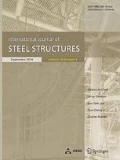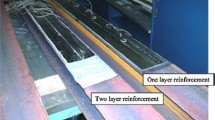Abstract
In steel members strengthened by carbon-fiber reinforced polymer (CFRP) plates, the thermal stresses are introduced in the steel members, the CFRP plates and the adhesive layers when temperature changes because the linear thermal expansion coefficients of steel and CFRP are mismatched. As so far, the authors proposed a technique to reduce the thermal stress in steel members strengthened by CFRP plates, which involves bonding aluminum alloy plates with CFRP plates. In the proposed method, the thermal stress in steel member can be reduced so that there are negligible levels of stress in steel member when the cross sectional areas of CFRP and aluminum plates are designed to correspond to the coefficient of thermal expansion of steel, even though the thermal stresses are introduced in the CFRP and aluminum plates. In this study, to confirm the maintaining the thermal stress reduction in steel member by proposed method, thermal stress measurement in steel plate strengthened by CFRP and aluminum plates was carried out about 21 months. In this research, the thermal stress introduced in the steel plate strengthened by CFRP plates was also measured. Furthermore, to assume the thermal shear and normal (peel) stresses in adhesive layers, FE analysis with plane stress element was employed. As the result, it was shown the thermal stresses in steel plate with CFRP plate were able to calculate by using composite theory and measured temperature. Furthermore, in steel plate strengthened by CFRP and aluminum plates, the thermal stress introduced in steel plate was negligible-small through the all-season. It was found the thermal stresses in steel plate with CFRP plates as well as CFRP and aluminum plates were also estimated by using composite theory and measured temperature. In the steel plate strengthened by CFRP and aluminum plates, the thermal shear and normal stresses in adhesive layer glued to steel plate become smaller than that in the conventional CFRP bonded specimen. However, the shear stress in adhesive layers between CFRP and aluminum plates in proposed method was higher than the thermal stress in adhesive layers between CFRP plates in conventional method.
Similar content being viewed by others
References
Ishikawa, T., Hattori, A. and Kawano, H. (2011). “Reduction of thermal stress induced in CFRP bonded steel plate by additionally bonding of aluminum alloy plates”, Journal of Japan Society of Civil Engineers, Ser. A1 (Structural Engineering & Earthquake Engineering (SE/EE)), Vol. 67, No. 2, pp. 336–350. (in Japanese)
Ishikawa, T., Tomida, D., Hattori, A., Kawano, H., Nagao, T. and Kobayashi, A. (2012). “Reduction of thermal stress induced in steel members by bonding CFRP plate on one side”, Journal of Japan Society of Civil Engineers, Ser. A2 (Applied Mechanics (AM)), Vol. 68, No. 2, pp. I_703-I_714. (in Japanese)
Ishikawa, T., Nagao, T., Kobayashi, A., Shimizu, M, Hattori, A. and Kawano, H. (2014). “Reduction of Thermal Stress Induced in A Steel Plate Strengthened by Bonded Aluminum-CFRP Composite”, Advanced in Structural Engineering, Vol. 17 No. 12, pp. 1771–1783.
Miller, T.C., Chajes, M.J., Mertz, D.R. and Hastings, J.N. (2001). “Strengthening of a steel bridge girder using CFRP plates”, Journal of Bridge Engineering, ASCE, Vol. 6, pp. 514–522.
Moy, S.S.J. and Bloodworth, A.G. (2007). “Strengthening a steel bridge with CFRP composites”, Structures & Buildings, Vol. 160, Issue SB2, pp. 81–93.
National Research Council-Advisory Committee on Technical Recommendations for Construction (2007). “Guidelines for the Design and Construction of Externally Bonded FRP Systems for Strengthening Existing Structures”, CNR-DT 202/2005.
Schnerch, D., Dawood, M., Rizkalla, S. and Sumner, E. (2007). “Proposed design guidelines for strengthening of steel bridges with FRP materials”, Construction and Building Materials, Vol. 21, pp. 1001–1010.
Täljsten, B., Hansen, C.S. and Schmidt, J.W. (2009). “Strengthening of old metallic structures in fatigue with prestressed and non-prestressed CFRP laminates” Construction and Building Materials, Vol. 23, pp. 1665–1677.
Tamai, H., Takamatsu, T., Hattori, A., Haitani, T. and Sakuraba, M. (2005). “Rehabilitation of secondary beam in chemical plant frame using carbon fiber reinforced plastic plate”, Journal of Construction Steel, JSSC, Vol. 13, pp. 545–552. (in Japanese)
Author information
Authors and Affiliations
Corresponding author
Rights and permissions
About this article
Cite this article
Ishikawa, T., Kawano, H., Nagao, T. et al. Thermal stress measurement in steel plate strengthened by CFRP and aluminum alloy plates. Int J Steel Struct 16, 1175–1185 (2016). https://doi.org/10.1007/s13296-016-0055-2
Received:
Accepted:
Published:
Issue Date:
DOI: https://doi.org/10.1007/s13296-016-0055-2




